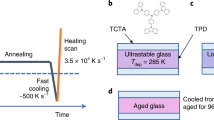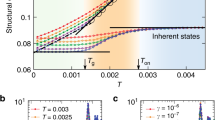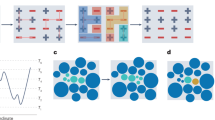Abstract
Most materials attain a glassy state at low temperatures under suitable methods of preparation. This state exhibits the mechanical properties of a solid, but shows microscopic structural disorder1,2. A comprehensive understanding of the glassy state is, however, still lacking3. A widespread assumption is that the non-exponential relaxation processes observed in the dynamics of glasses — and also in protein dynamics, protein folding and population dynamics — are (in common with other manifestations of complex dynamics) strongly influenced by the underlying energy landscape associated with the structural configurations that the system may adopt. But concrete evidence for this in studies of glass formation has been scarce. Here we present such evidence, obtained from computer simulations of a model glass-forming liquid. We demonstrate that the onset of non-exponential relaxation corresponds to a well defined temperature below which the depth of the potential-energy minima explored by the liquid increases with decreasing temperature, and above which it does not. At lower temperatures, we observe a sharp transition when the liquid gets trapped in the deepest accessible energy basin. This transition temperature depends on the cooling rate, in a manner analogous to the experimental glass transition. We also present evidence that the barrier heights separating potential-energy minima sampled by the liquid increase abruptly at a temperature above the glass transition but well below the onset of non-exponential relaxation. This identification of a relationship between static, topographic features of the energy landscape and complex dynamics holds the promise of a clearer, possibly thermodynamic, understanding of the glass transition.
This is a preview of subscription content, access via your institution
Access options
Subscribe to this journal
Receive 51 print issues and online access
$199.00 per year
only $3.90 per issue
Buy this article
- Purchase on Springer Link
- Instant access to full article PDF
Prices may be subject to local taxes which are calculated during checkout




Similar content being viewed by others
References
Debenedetti, P. G. Metastable Liquids (Princeton Univ. Press, Princeton, (1996).
Ediger, M. D., Angell, C. A. & Nagel, S. R. Supercooled liquids and glasses. J. Phys. Chem. 100, 13200–13212 (1996).
Anderson, P. W. Through the glass lightly. Science 267, 1615 (1995).
Angell, C. A. Formation of glasses from liquids and biopolymers. Science 267, 1924–1935 (1995).
Kauzmann, W. The nature of the glassy state and the behavior of liquids at low temperatures. Chem. Rev. 43, 219–256 (1948).
Gibbs, J. H. & DiMarzio, E. A. Nature of the glass transition and the glassy state. J. Chem. Phys. 28, 373–383 (1958).
Stillinger, F. H. Supercooled liquids, glass transitions, and the Kauzmann paradox. J. Chem. Phys. 88, 7818–7825 (1988).
Heuberger, G. & Silescu, H. Size dependence of tracer diffusion in supercooled liquids. J. Phys. Chem. 100, 15255–15260 (1996).
Chang, I., Fujara, F., Geil, B., Heuberger, G. & Silescu, H. Translational and rotational molecular motion in supercooled liquids studied by NMR and forced Rayleigh scattering. J. Non-Cryst. Solids 172–174;, 248–255 (1994).
Cicerone, M. T., Blackburn, F. R. & Ediger, M. D. How do molecules move near T g? Molecular rotation of six probes in o-terphenyl across 14 decades in time. J. Chem. Phys. 102, 471–479 (1995).
Parisi, G. New ideas in glass transitions.in Proc. Int. Workshop on The Morphology and Kinetics of Phase Separating Complex Fluids(eds Chen, S. H., Mallamace, F. & Tartaglia, P.) Il Nuovo Cimento D (in the press).
Goldstein, M. Viscous liquids and the glass transition: a potential energy barrier picture. J. Chem. Phys. 51, 3728–3739 (1969).
Goldstein, M. Viscous liquids and the glass transition. VII. Molecular mechanisms for a thermodynamic second order transition. J. Chem. Phys. 67, 2246–2253 (1977).
Stillinger, F. H. Atopographic view of supercooled liquids and glass formation. Science 267, 1935–1939 (1995).
Götze, W. & Sjögren, L. Relaxation processes in supercooled liquids. Rep. Prog. Phys. 55, 241–376 (1992).
Bengtzelius, U., Götze, W. & Sjölander, A. Dynamics of supercooled liquids and the glass transition. J. Phys. C 17, 5915–5934 (1984).
Leutheusser, E. Dynamical model for the liquid-glass transition. Phys. Rev. A 29, 2765–2773 (1984).
Angell, C. A. Perspective on the glass transition. J. Phys. Chem. Sol. 49, 863–870 (1988).
Angell, C. A. in Complex Behavior in Glassy Systems (eds Rubi, M. & Perez-Vicente, C.) 1–21 (Springer, Berlin, (1997).
Weber, T. A. & Stillinger, F. H. Local order and structural translations in amorphous metal-metalloid alloys. Phys. Rev. B 31, 1954–1963 (1985).
Kob, W. & Andersen, H. C. Testing mode-coupling theory for a supercooled binary Lennard-Jones mixture: the van Hove correlation function. Phys. Rev. E 51, 4626–4641 (1995).
Donati, C., Douglas, J. F., Plimpton, S. J., Poole, P. H. & Glotzer, S. C. String-like cooperative motion in a supercooled liquid. Phys. Rev. Lett. 80, 2338–2342 (1998).
Stillinger, F. H. & Weber, T. A. Packing structures and transitions in liquids and solids. Science 225, 983–989 (1984).
Angell, C. A.et al. in Slow Dynamics in Condensed Matter: Proc. 1st Tohwa Univ. Int. Symp. (eds Kawasaki, K., Kawakatsu, T. & Tokuyama, M.) 3–19 (AIP Conf. Proc. 316, Am. Inst. Physics, New York, (1992).
Colucci, D. M.et al. Isochoric and isobaric glass formation: similarities and differences. J. Polym. Sci. B: Polym. Phys. 35, 1561–1573 (1997).
Hansen, J.-P. & McDonald, I. R. Theory of Simple Liquids (Academic, London, (1986).
Fox, J. R. & Andersen, H. C. Molecular dynamics simulations of a supercooled monoatomic liquid and glass. J. Phys. Chem. 88, 4019–4027 (1984).
Wahnström, G. Molecular-dynamics study of a supercooled two-component Lennard–Jones system. Phys. Rev. A 44, 3752–3764 (1991).
Stoddard, S. D. & Ford, J. Numerical experiments on the stochastic behavior of a Lennard–Jones gas system. Phys. Rev. A 8, 1504–1512 (1973).
Acknowledgements
We thank C. A. Angell, S. Glotzer, F. Sciortino and H. E. Stanley for discussions. This work was supported by the US Department of Energy and the Petroleum Research Fund.
Author information
Authors and Affiliations
Corresponding author
Rights and permissions
About this article
Cite this article
Sastry, S., Debenedetti, P. & Stillinger, F. Signatures of distinct dynamical regimes in the energy landscape of a glass-forming liquid. Nature 393, 554–557 (1998). https://doi.org/10.1038/31189
Received:
Accepted:
Issue Date:
DOI: https://doi.org/10.1038/31189
This article is cited by
-
Tracer dynamics in dense soft colloidal suspensions: from free diffusion to hopping
Indian Journal of Physics (2024)
-
Distinct relaxation mechanism at room temperature in metallic glass
Nature Communications (2023)
-
The intimate relationship between structural relaxation and the energy landscape of monatomic liquid metals
Scientific Reports (2021)
-
Unveiling the predictive power of static structure in glassy systems
Nature Physics (2020)
-
Connecting glass-forming ability of binary mixtures of soft particles to equilibrium melting temperatures
Nature Communications (2020)
Comments
By submitting a comment you agree to abide by our Terms and Community Guidelines. If you find something abusive or that does not comply with our terms or guidelines please flag it as inappropriate.



